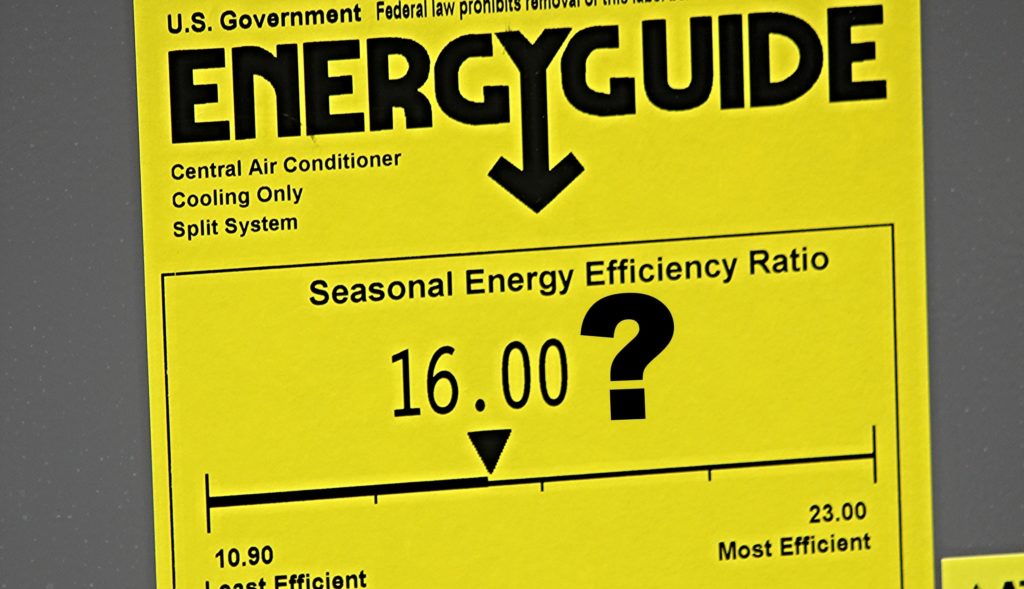
Did you know that it’s possible to raise the SEER rating of your HVAC system without investing in a completely new AC condenser? This loophole 16 SEER involves adding equipment to your current system to make it more efficient.
Consumers should be aware of this when buying and installing a new high-efficiency HVAC system in their home.It is the job of contractors to educate their customers when they are getting several bids where price differences can vary widely despite looking identical on the surface. Not explaining the underlying differences leaves customers puzzled or mad, with no roadmap, after receiving a much lower bid.
Let’s discuss how homeowners can raise their HVAC equipment’s SEER rating.
How is this done?
The measurements of HVAC cooling efficiency are SEER and EER. The higher these numbers, the better, much like MPGs on your car. SEER stands for Seasonal Energy Efficiency Rating, and EER stands for Energy Efficiency Ratio.
Air Conditioning and Heating equipment manufacturers have figured out that, by matching a 14.5 SEER condenser with complementary products, a 16 SEER AHRI rated system can be created. This is most often done by matching the condenser with a variable speed furnace and a horizontal slab coil (often a third party). The result of this added equipment is a more efficient system overall.
Specific Examples of Loop Hole Equipment
Reaching 16 SEER in this context is based on all variables working together. Not all 14 SEER condensers can reach 16 SEER efficiencies. It depends on both the complimenting products and the size of the condenser. Many five-ton condensers cannot hit 16 SEER, even with variable speed furnaces and slab coils added.
Here are some examples of general matchups that reach 16 SEER.
Ruud 14.5 SEER Reach 16 SEER:
- Condenser- 14AJM
- Coil- Aspen Slab(third Party)
- Furnace- RGPE 2-Stage 80%
Trane XB14 Reach 16 SEER:
- Condenser- XB14
- Coil- ADP Slab
- Furnace- XC80
Compared to “true” 16 SEER prices, this typically causes a $750-$2,000 difference in sale price.
How did this type of HVAC equipment even come about?
The Genesis of this movement is probably a product of the tax credits made available in 2009. Remember the Cash for Clunkers campaign where you could get a tax benefit if you bought a more efficient car? There was a similar program for air conditioning. Qualifying systems reaching a minimum efficiency of 16 SEER could get a $1500 tax credit. This was great for many in the HVAC industry.
Still, since the economy was depressed, not everyone could afford a full-priced 16 SEER. They were and are expensive for many consumers. Rising from the customer demand for a mixture of the specific 16 SEER efficiency at a lower price point came the popularity of the 14.5 SEER AC condenser loophole. During this time (and probably since), 16 SEER has become a target for many consumers and contractors. A mindset has been built that, if you want a high-efficiency HVAC system, you need to at least purchase a 16 SEER.
So you must ask at this point: is it too good to be true? Are there problems with this?
Is loophole 16 SEER equipment an issue?
Few can argue the appeal of getting high-efficiency equipment for a lower price, but consumers must also consider additional variables when buying a new HVAC system. These include:
- Installation quality
- Equipment/labor warranties
- Comfort benefits.
Not all air conditioning units are created equal. Some have shorter or longer manufacturer warranties depending on the equipment purchased. Nor are all HVAC company installers created equal. A large portion of your system’s true efficiency is contingent on the quality of the installation. This is where experience and training are key.
When buying or selling an HVAC system, additional questions should be asked to ensure customers are receiving the best quality equipment and installation that will keep them comfortable for the next 10-20 years.
For more information, contact Mission AC & Plumbing today.



